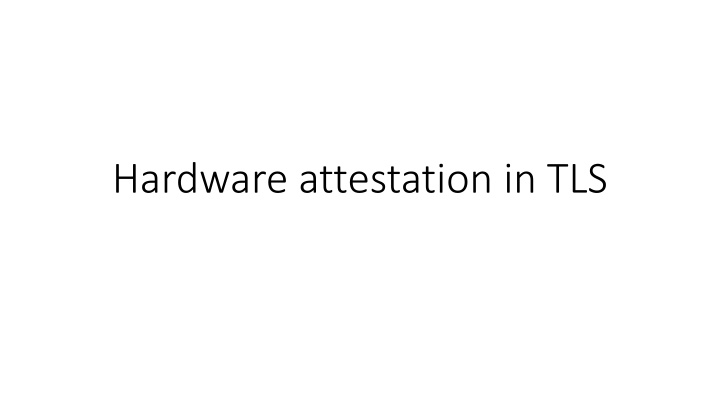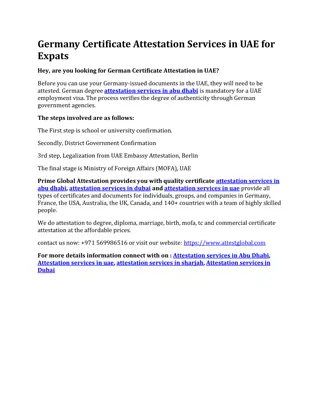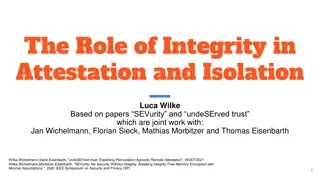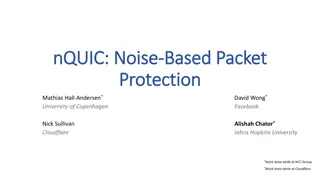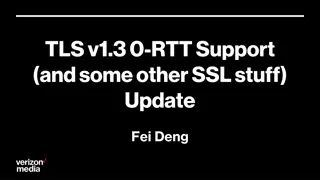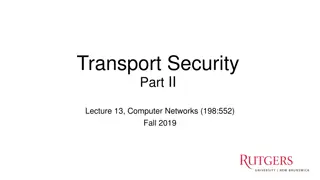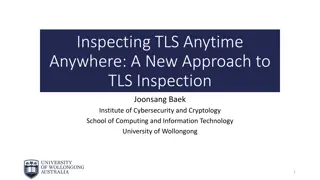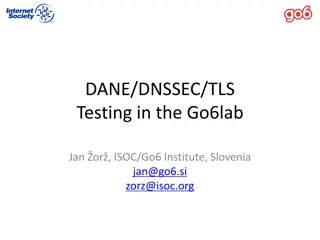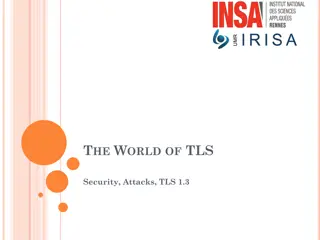Enhancing Security with Hardware Attestation in TLS
The hardware attestation in TLS presentation explores the theory and practice of remote attestation, emphasizing the need to improve workload authentication beyond software-bound trust. It delves into the use cases, remote attestation data flow, and the significance of Transport Layer Security (TLS) in establishing secure communication channels.
Download Presentation

Please find below an Image/Link to download the presentation.
The content on the website is provided AS IS for your information and personal use only. It may not be sold, licensed, or shared on other websites without obtaining consent from the author.If you encounter any issues during the download, it is possible that the publisher has removed the file from their server.
You are allowed to download the files provided on this website for personal or commercial use, subject to the condition that they are used lawfully. All files are the property of their respective owners.
The content on the website is provided AS IS for your information and personal use only. It may not be sold, licensed, or shared on other websites without obtaining consent from the author.
E N D
Presentation Transcript
Who am I? Ionu Mihalcea Senior Software Engineer at Arm ionut.mihalcea@arm.com https://www.linkedin.com/in/ionut-mihalcea-985314a5/ @ionut-arm
Overview The theory Remote attestation TLS The practice MbedTLS Parsec Veraison
The theory Remote attestation, TLS, and standards
What are we trying to improve? Current status quo: Attacker assumed on communication path Workload authentication is rooted primarily in software Trust is necessarily bound to the entity provisioning the workload Hardware backing is usually reserved for protecting an identity key (e.g., HSMs) Can we use remotely-verifiable information about the security state of the workload, beyond key state/backing?
Use cases PRIVATE IDENTITY KEY SERVICE CLOUD WORKLOAD ATTESTATION CERTIFICATE CREDENTIAL ATTESTATION CERTIFICATE CREDENTIAL EDGE DEVICE LOCAL DEVICE PRIVATE IDENTITY KEY IoT/Edge Device Onboarding Confidential Computing
Remote attestation A class of hardware-backed mechanisms which enables a relying party1 to cryptographically verify the state of a previously-untrusted workload The attester device can issue its own credentials backed by a certificate provided by the manufacturer 1 Using RATS terminology in this presentation 7
Remote attestation data flow Provision device and its identity Authentication
Transport Layer Security (TLS) TLS is a ubiquitous component of network security, offering confidentiality and integrity to communication via a secure channel The secure channel is established following a handshake protocol The handshake protocol enables authentication between the two peers
TLS v1.3 Handshake Client Server Client Hello (supported cipher suites, any extensions ), Key Share Server Hello (chosen cipher suite, any extensions ), Key share, Certificate, Certificate Verify, Finished (Mostly) Encrypted Certificate (Optional), Certificate Verify (Optional), Finished Secure data channel
Goals To enhance authentication via remote attestation in TLS To support a wide range of platforms To support most common deployment patterns
Security and privacy Planning to formally verify the extensions Meticulously working to prevent attacks (e.g., relay/splicing) Attestation credentials can reveal a lot of private and security- relevant metadata but this could be (partially) mitigated by use of specially-crafted attestation results
The practice Prototype and ecosystem
Big picture Producing an end-to-end proof of concept From attester through a TLS implementation, to a verifier Uses background-check model, TPM2.0 as a RoT Open-sourcing the entire stack The components themselves are open-source software Our work is harbored under the CCC Attestation SIG
Prototype Architecture Verification Verifier Relying Party Authentication Attester Platform State Attester Private + Attestation Key(s) Attester RoT
Prototype Architecture Verification Verifier Server TLS Stack (MbedTLS) Server Certificate Handshake (Augmented) Secure Channel Attestation Evidence TLS Stack (MbedTLS) Client Platform State Client Private + Attestation Key(s) Client RoT
Parsec: A Platform Abstraction For Security Cloud-Native Applications, Any Programming Language, Any Runtime, Any Orchestration Any Platform, Any Architecture, Any Hardware Trusted Services Discrete TPM Firmware TPM Local HSM Remote HSM Custom
What is Veraison? An Open-Source Library of Components to Build Attestation Verifier Services Verifier Service Standard Provisioning Data Model Verification API verify endorse Any Architecture, Any Deployment, Any Policy Application/Service (Relying Party) deploy attest Device Manufacturing
Enhancements to Parsec A (generic) key attestation API Specific service configuration options (attesting key, TPM PCRs ) An API to enable generation of endorsements
Extensions to Veraison Support for the attestation scheme required for the prototype: New plugin for evidence New plugin for endorsements
MbedTLS Implementation of TLS and DTLS protocols Provides a reference implementation of the PSA Cryptography API Small code footprint, more suitable for IoT and Edge devices
Open source ecosystem Pooling expertise and work across the industry Open sourcing should be more than an item on a checklist It should bring a continuous involvement in the ecosystem We ve been seeding and expanding projects in CNCF and CCC to build communities
Rust ecosystem Released a number of crates relevant to RoTs: tss-esapi cryptoki psa-crypto The more important goal is to make these hardware features easier to consume via the Parsec Rust client
Go ecosystem Released the veraison/go-cose package, used quite broadly Notary Sigstore Also other packages relevant to remote attestation and verification: Veraison/swid Veraison/corim
Attestation as a plug-in Verification Verifier Server Authentication Server QUIC Stack TLS Stack Server Certificate Authentication Attestation Evidence Workload QUIC Stack TLS Stack Client Platform State Client Private + Attestation Key(s) Client RoT
Remote attestation is a viable authentication mechanism for TLS Our design aims to be as flexible and secure as possible We want to reify the theory into an end-to-end prototype We re hoping that the prototype will serve as a model for integrating remote attestation in other protocols
Bibliography TLS extension draft: https://datatracker.ietf.org/doc/draft-fossati-tls- attestation/ CCC project repo: https://github.com/CCC-Attestation/attested-tls- poc Parsec: https://parsec.community/ Veraison: https://github.com/veraison MbedTLS: https://www.trustedfirmware.org/projects/mbed-tls/ Draft repo: https://github.com/yaronf/draft-tls-attestation RATS architecture: https://datatracker.ietf.org/doc/rfc9334/
